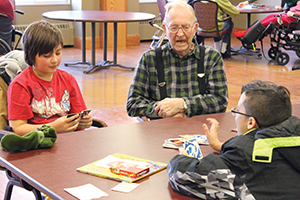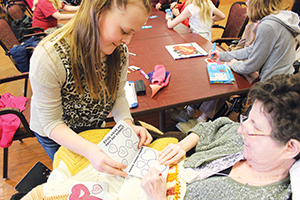By RENEE STOVSKY
Ask the fourth graders at Clearview Elementary School near St. Cloud, Minn., what they've learned from participating in an intergenerational program at nearby St. Benedict's Senior Community and their answers are as varied as the children themselves.

Leroy Kiley, a resident at St. Benedict's Senior Community in St. Cloud, Minn., observes a card game between Jude Litterest, left, and Jadyn Gagnon. The boys visit seniors at St. Benedict's twice each month with their fourth grade classmates from Clearview Elementary School.
For 10-year-old Kira Frisbie, whose special partner is Lila McIntyre, a former fourth grade teacher herself, it's a chance to "practice being patient and not being shy." Most important, though, says Kira, it's "learning to work like a team."
Her classmate, Kayli Clymer, says it has taught her how to communicate with older people who may not hear very well or can be forgetful. "Sometimes their brains don't work like mine so I have to explain things in different ways," she says. "But mainly, I've learned that a lot of older people are lonely, and they want us to come and have fun with them."
Morale boost
The residents of St. Benedict's have their unique perspectives on the intergenerational program as well. For Victoria Budig, 72, it evokes the same kind of warm feeling she says she remembers from "going home after you work all day and there are your kids.
"I see love in their faces, and it keeps my morale up," she says.
For Caroline Dixon, 61, the program offers "a breath of fresh air and a youthful outlook on life. Children know so much more than we think they do," she says. There's a practical benefit to having a 10-year-old partner, she adds. "It's like having a personal computer technician, and I need that!"
Reading buddies
The grade school/senior community connection began four years ago, when Clearview was awarded an international reading project grant and chose to implement it by sharing a love of literature with St. Benedict's. Twice a month, children would visit and practice reading a book of their choice to residents who were interested in not only listening to them, but acting as reading coaches when need be.
Fourth grade teacher Andrea Coulter expanded the program when she arrived at Clearview three years ago. "I had been involved in a class visitation program through the Veterans Administration at another school, so I already had an appreciation for the value of mixing generations and letting them learn from each other," she says.

Fourth grader Elli Kiscaden assists as Pearl Krueger concentrates on drawing funny faces during a class visit to St. Benedict's.
Coulter kept the reading buddy aspect of the program, but added crafts and game time to the mix of activities she carefully plans for the twice monthly visits. "The art projects generally reflect upcoming holidays or have seasonal themes — pumpkins in October, valentines in February — and they are something the children can give residents to decorate their rooms," she says. "The games are educational — card games, Scrabble Junior — as well as a good way to encourage fun and participation."
Just like Christmas
In that, the program has obviously succeeded. Coulter says it's hard to contain the children's excitement on the day of their class visit. But Christine Bakke, care center administrator at St. Benedict's, which is affiliated with St. Cloud Hospital and part of the CentraCare Health system, says the level of excitement is equally high among participating residents.
"The day the children are scheduled to come, this place comes alive. The residents eat breakfast, go to Mass and then hurry into the meeting room like it's Christmas morning," she says. "When the kids finally arrive, it's wonderful to watch the smiles and laughter. It gives our seniors such a sense of connection and purpose to help in the development of young minds."
That's why, when funding for the intergenerational program was due to end, St. Benedict's reached out to donors and began a fundraising campaign to ensure that the partnership could continue. (Though this program serves long-term nursing care residents, St. Benedict's houses more than 500 people through facilities that also include independent apartments, assisted living apartments, short-stay nursing care and Alzheimer's care.)
"We raised more than $5,000 — enough to subsidize costs for another five years," says Bakke. "And if the school is willing to continue the program beyond that, we are committed to finding a way to do that as well."
In fact, the program has been so successful that both St. Benedict's and Clearview were recognized at Care Providers of Minnesota's annual convention in December for creating a partnership with a community group outside the care profession that improves the quality of life for residents.
Awards aside, it's the life experiences that make the program special for all its participants.
Mutual admiration
Coulter says her class reflects upon each visit when they return to school, brainstorming how to overcome difficulties as well as sharing successes.
"Honestly, I think the kids are the main beneficiaries of the program; their self-esteem grows by leaps and bounds. The seniors are so positive with them, telling them they are great readers and wonderful artists," she says. In more than one instance, she adds, children and their families have maintained relationships with St. Benedict's residents beyond the end of the school year.
St. Benedict's staff members also continue to try to improve the program based on residents' reactions and experiences.
"Our participants are both ambulatory and wheelchair-bound, and though cognitively they are fine, some struggle verbally or have hearing problems. We try to help facilitate interaction, though the kids are naturally great at connecting," says Hilary Studenski, a therapeutic recreation coordinator.
Watching the way residents respond to the program, says Studenski, makes her work worthwhile as well. "My job is to ensure quality of life, and when I see the way our seniors engage with the kids — leaning in, making eye contact, asking about school — it's such a kick. Some of these people don't choose to come out of their rooms at any other time. Yet they light up when given the chance to help a child learn," she says. "It seems so simple, but relationships are all important at any age."
Copyright © 2015 by the Catholic Health Association
of the United States
For reprint permission, contact Betty Crosby or call (314) 253-3477.